The best time to visit Taiwan is during fall (October-December) when you’ll enjoy mild temperatures between 20-25°C and minimal rainfall. You’ll avoid both summer’s intense heat and the Chinese New Year rush in January-February. Spring offers pleasant conditions too, but expect more frequent showers. For budget-friendly travel, skip the July-August peak season when prices surge 30-50%. Whether you’re headed to tropical beaches or mountain trails, each region’s unique climate patterns can dramatically shape your experience.
Explore East Asia
Find the perfect time to visit these travel hotspots
Key Takeaways
- October to March offers the most pleasant weather with cooler temperatures and lower humidity during the northeast monsoon season.
- Avoid July-August when summer crowds peak and January-February during Chinese New Year rush for better prices and availability.
- Spring (March-May) brings frequent rainfall but moderate temperatures, ideal for mountain hiking and viewing wildlife migrations.
- Southern beaches are best from March to October, while northern hot springs are most enjoyable from November to February.
- Book accommodations 3-4 months ahead as prices increase 30-50% during peak seasons and availability becomes limited.
Peak Season Travel Guide
When planning a trip to Taiwan during peak season, you’ll need to navigate two distinct busy periods: the Chinese New Year rush in January-February and the summer holiday crowds in July-August. During these times, transportation hubs operate at maximum capacity, and accommodation availability becomes scarce, especially in major cities.
You’ll want to book your flights and hotels 3-4 months in advance, as prices can spike 30-50% higher than off-peak rates. Popular destinations like Sun Moon Lake, Taroko Gorge, and Kenting National Park get particularly crowded, so consider exploring lesser-known regions like Hualien’s East Rift Valley instead. If you’re set on visiting main attractions, schedule your activities for weekdays to avoid the heaviest crowds. The summer months offer a unique opportunity to enjoy Taiwan’s delicious seasonal fruits like mangoes and lychees while exploring indoor attractions.
To maximize your travel freedom, secure multi-day transit passes early and use local booking apps like Klook for advance tickets to attractions. This strategy helps you bypass long queues and inflated on-site prices.
Weather Patterns Throughout the Year
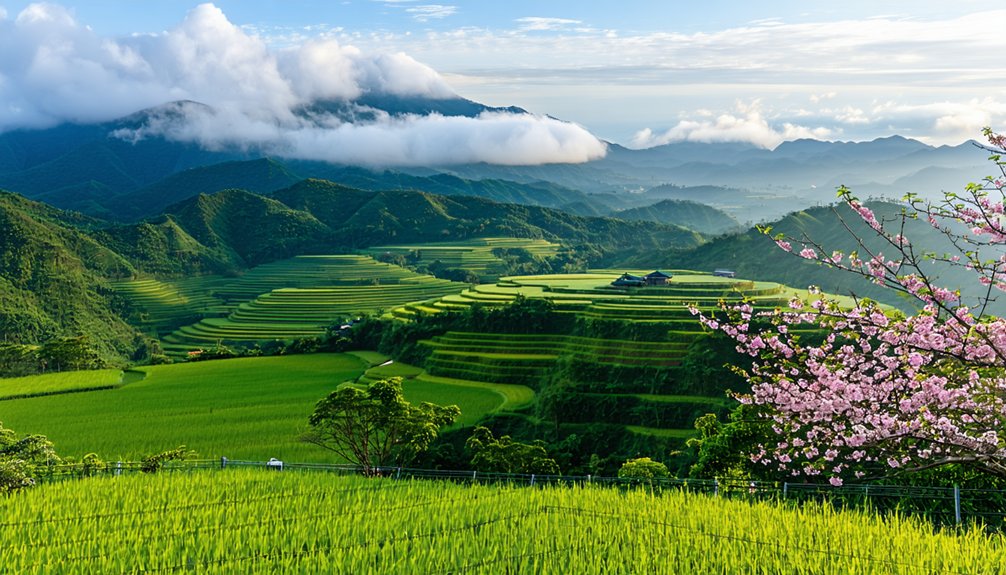
Understanding Taiwan’s weather is key to timing your visit effectively, regardless of whether you’re traveling during peak seasons or not. The island experiences distinct seasonal changes that you’ll want to factor into your travel plans.
You’ll find Taiwan’s weather governed by monsoon seasons, with the northeast monsoon bringing cooler temperatures from October to March, and the southwest monsoon bringing warmer, humid conditions from April to September. Summers can be quite hot and sticky, while winters remain mild, especially in the northern regions. Spring brings pleasant temperatures but frequent rainfall. The average temperature in Taipei fluctuates between 16.5°C to 30.5°C throughout the year.
Watch out for typhoon patterns, which typically occur between July and September. These powerful storms can disrupt travel plans and outdoor activities. The good news is that Taiwan’s weather forecasting systems are highly advanced, so you’ll have ample warning to adjust your itinerary if a typhoon approaches. The shoulder seasons of spring and fall often offer the most comfortable conditions for exploring.
Regional Climate Differences
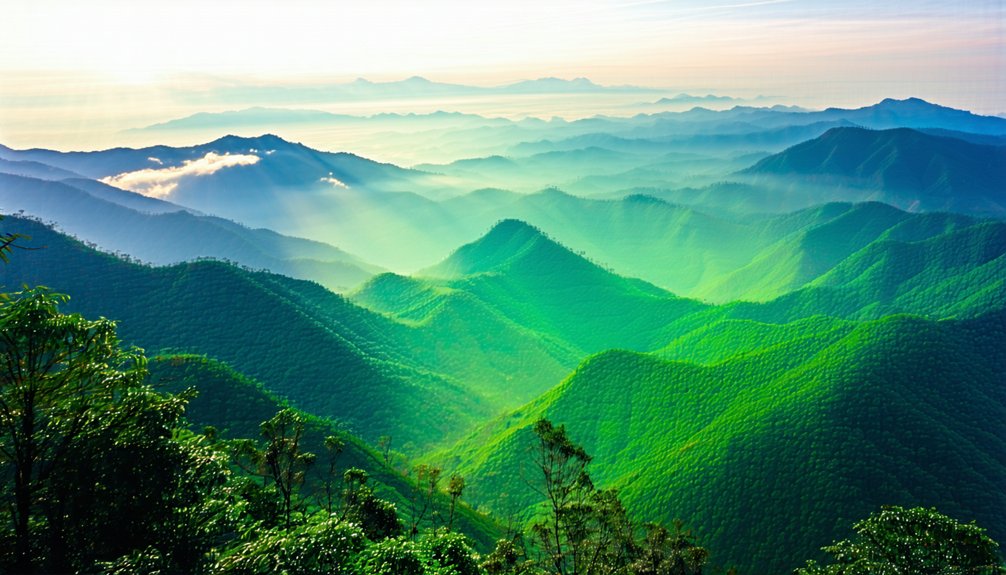
You’ll find distinct climate patterns between Taiwan’s north and south, with the tropical south averaging warmer temperatures year-round at 26.82°C while the subtropical north experiences cooler winters around 15°C. The island’s central mountain ranges create another climate divide, where high-altitude areas like Yushan can see subfreezing temperatures and occasional snow, while coastal regions enjoy milder conditions influenced by marine air masses. The region receives 2400 mm annually of precipitation, primarily from summer tropical cyclones and monsoons. These regional differences affect everything from fruit harvests to outdoor activities, with southern beaches being most pleasant from March to October and northern hot springs offering ideal conditions from November through February.
North Vs South Patterns
Despite sharing a relatively small landmass, Taiwan’s northern and southern regions experience distinctly different climate patterns throughout the year. You’ll find the north averages 22°C annually with steady year-round rainfall, while the south runs warmer at 24°C with pronounced wet and dry seasons.
If you’re planning around typhoon preparedness, note that southern regions face higher risks during July-October, with increased flooding potential and agricultural impacts on rice and pineapple crops. The north, while not immune, typically experiences less severe effects on its tea and orchard production.
Winter travelers should expect cooler temperatures around 15°C in the north, while the south stays milder at 19°C. Summer brings similar highs to both regions, but you’ll encounter particularly higher humidity in the south. The Kuroshio Current significantly influences these patterns, bringing warm ocean currents that affect rainfall distribution across the island.
Mountain and Coast Contrasts
Taiwan’s dramatic elevation changes create stark climate contrasts between its mountains and coastlines. You’ll experience temperatures dropping 0.6°C for every 100m you climb, with alpine zones above 2,500m averaging below 10°C annually, while coastal areas stay mild at 18-25°C year-round.
If you’re tracking seasonal wildlife migrations, head to the mountains during spring when temperatures warm gradually, creating ideal conditions for observing diverse species. The island’s subtropical monsoon climate influences both temperatures and rainfall patterns throughout the year. For typhoon risk mitigation, avoid coastal areas from June to October when wind speeds can exceed 150km/h. Instead, explore mountain regions during April-June or September-October when weather’s stable and landslide risks are minimal. Mountain trekkers should note that eastern slopes receive twice the rainfall of western valleys, creating unique microclimates worth exploring.
Festival and Event Calendar
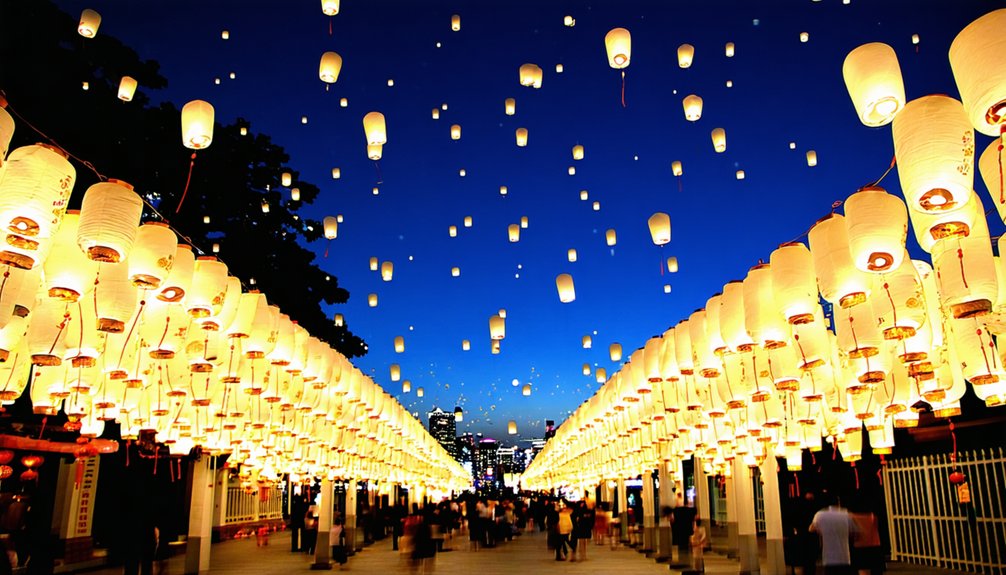
Taiwan’s festival calendar offers a vibrant mix of traditional celebrations, modern cultural events, and seasonal festivities throughout the year. You’ll find major holidays like Chinese New Year and the Lantern Festival drawing massive crowds in winter months, while summer brings the Dragon Boat Festival and Ghost Month celebrations that showcase the island’s rich cultural heritage. Between these anchor events, you can experience everything from the Taitung Hot Air Balloon Festival to the Taipei Jazz Festival, making any season an excellent time to explore Taiwan’s dynamic event scene. Spring 2025 brings an especially diverse lineup of performances, with K-pop concerts scheduled across multiple cities including CNBLUE in Kaohsiung and NCT 127 in Taoyuan.
Major Holiday Celebrations
Throughout the year, you’ll find Taiwan’s calendar filled with vibrant festivals and cultural celebrations that showcase the nation’s rich heritage. The Lunar New Year kicks off with six days of religious traditions, including temple visits and dragon dances, while families exchange red envelopes and savor culinary specialties like niángāo.
April brings the combined Tomb Sweeping and Children’s Day, when families honor ancestors and celebrate youth. The Dragon Boat Festival in late May features exciting races and traditional zòngzi dumplings. Come autumn, you can join moon-viewing parties and barbecues during the Mid-Autumn Festival, where mooncakes take center stage. The year’s celebrations peak with National Day in October, treating you to military parades, fireworks, and cultural exhibitions at Liberty Square. Visitors should note that Indigenous Peoples Day on August 1 is celebrated by specific sectors, offering unique cultural insights into Taiwan’s aboriginal heritage.
Cultural Festivals Year-Round
Three distinct festival categories showcase Taiwan’s dynamic cultural tapestry year-round. You’ll discover traditional dance performances at martial arts parades, indigenous ritual celebrations, and contemporary art festivals spread across the calendar.
The calendar peaks with these key festival periods:
- February-March: Experience the thrilling Yanshui Beehive Fireworks and Bombing of Master Handan rituals
- July-September: Join the Amis tribe’s vibrant harvest celebrations in Hualien
- November-December: Witness the spiritual Pas’ta’ai ceremony and Puyuma New Year rituals
You’re free to explore cultural events in every season, from the aerial spectacles of hot air balloons in Taitung to the dramatic Song Jiang Battle performances in Kaohsiung. Each festival offers unique insights into Taiwan’s rich heritage and living traditions. The Taiwan International Festival of Arts brings world-class performances in theater, dance, and music to venues across Taipei, Taichung, and Kaohsiung each spring.
Seasonal Event Highlights
Seasonal events kick off each winter with a dazzling array of festivals that’ll keep you busy through February. You’ll join thousands at the Taipei Marathon, marvel at Disney-themed lights at Christmasland, and witness the iconic Taipei 101 New Year’s fireworks. For unique cultural immersion opportunities, don’t miss the Pingxi Sky Lantern Festival, where you’ll release glowing wishes into the night sky.
Watch out for seasonal transportation challenges during these peak events, especially around New Year’s Eve when crowds flock to Taipei. Spring brings a different energy with the nationwide Tomb Sweeping Day, when locals honor their ancestors. If you’re seeking an adrenaline rush, the Yanshui Fireworks Festival offers an intense experience where participants engage in traditional firework battles. The summer months of July and August are best avoided due to typhoon season and uncomfortably humid conditions.
Budget-Friendly Travel Periods
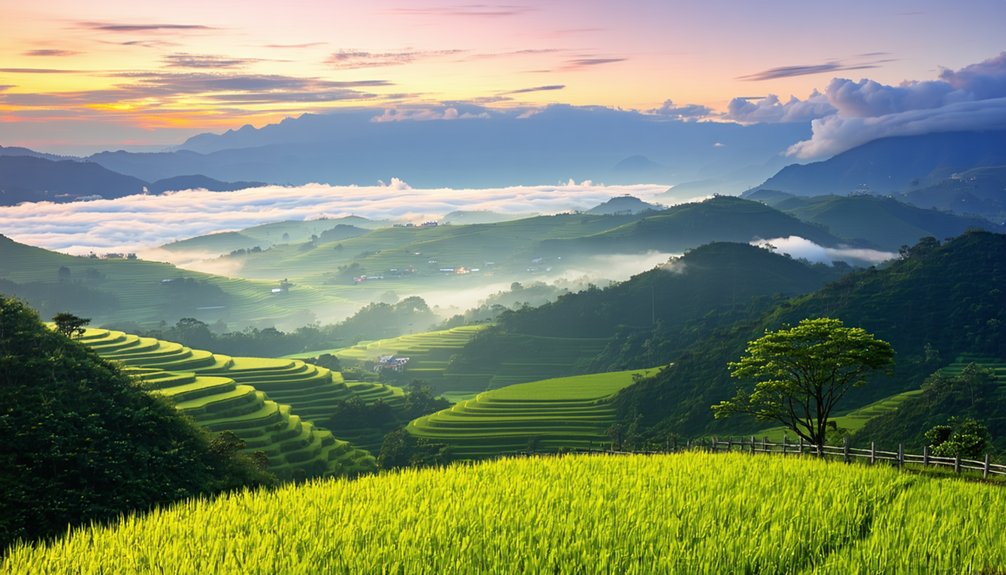
For savvy travelers looking to maximize their budget in Taiwan, the shoulder seasons of March-May and September-November offer the best value. You’ll find discount airfare opportunities with international flights up to 18% cheaper than peak summer rates, especially if you’re flexible with midweek departures from Southeast Asia, which can save you an additional 22%.
During these periods, you’ll benefit from:
- Hotel rates 15-20% below peak prices with high room availability
- Discounted tour packages and attraction combo tickets with 10-15% savings
- Money saving transportation options through year-round off-peak pricing
If you’re really looking to stretch your dollar, consider visiting during winter months (excluding holiday periods). December through February offers the deepest discounts, with urban hotel rates dropping 25-30% and hostel beds available for under $15 USD. Plus, you’ll find seasonal meal deals at local hot pot restaurants for $8-$12 per person. Take advantage of the buy-one-get-one-free HSR tickets currently being promoted by tourism agencies to further reduce your transportation costs.
Avoiding Crowds and Peak Rates
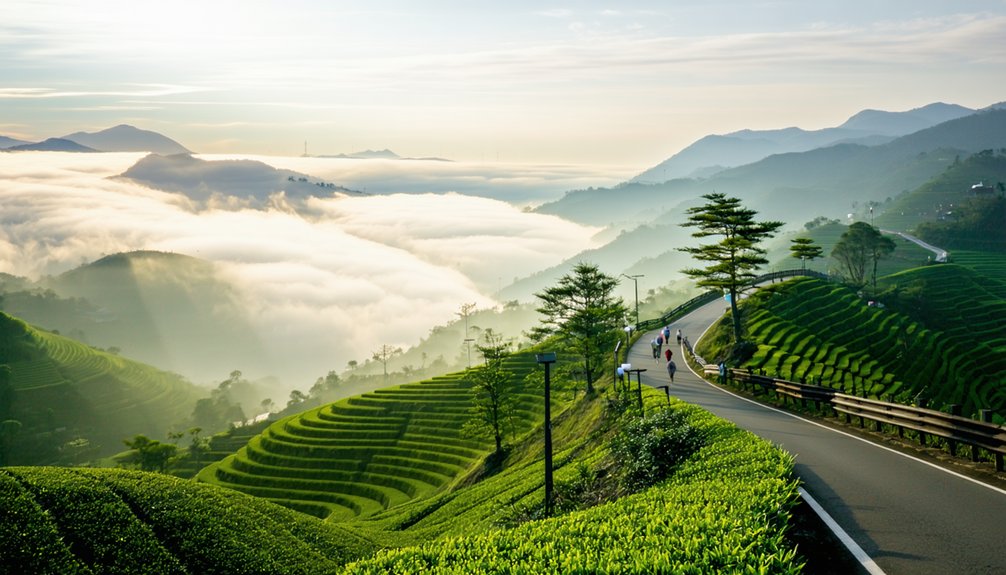
Timing your visit strategically can make all the difference in experiencing Taiwan’s attractions comfortably and cost-effectively. You’ll find the best off season discounts from April to December, excluding summer holidays and major festivals. For authentic local dining experiences without the crowds, plan your visits on weekdays when tourist hotspots see markedly lower foot traffic. Major destinations see an influx of visitors during Chinese New Year celebrations, so consider alternative timing if seeking a quieter experience.
| Season | Crowd Level | Savings Potential |
|---|---|---|
| Spring (Mar-May) | Moderate | 20-30% |
| Summer (Jun-Aug) | High | 10-15% |
| Fall (Sep-Nov) | Low | 30-40% |
| Winter (Dec-Feb) | Very Low | 25-35% |
| Shoulder (May/Oct) | Low-Moderate | 20-25% |
To maximize your experience, target shoulder seasons in late May or early October. You’ll enjoy balanced weather and reduced crowds, especially in central Taiwan where visitor numbers drop by 40% during off-peak months. Consider exploring remote regions like the Penghu Islands, where you’ll encounter 45% fewer tourists than in Taipei.
Seasonal Activities and Attractions
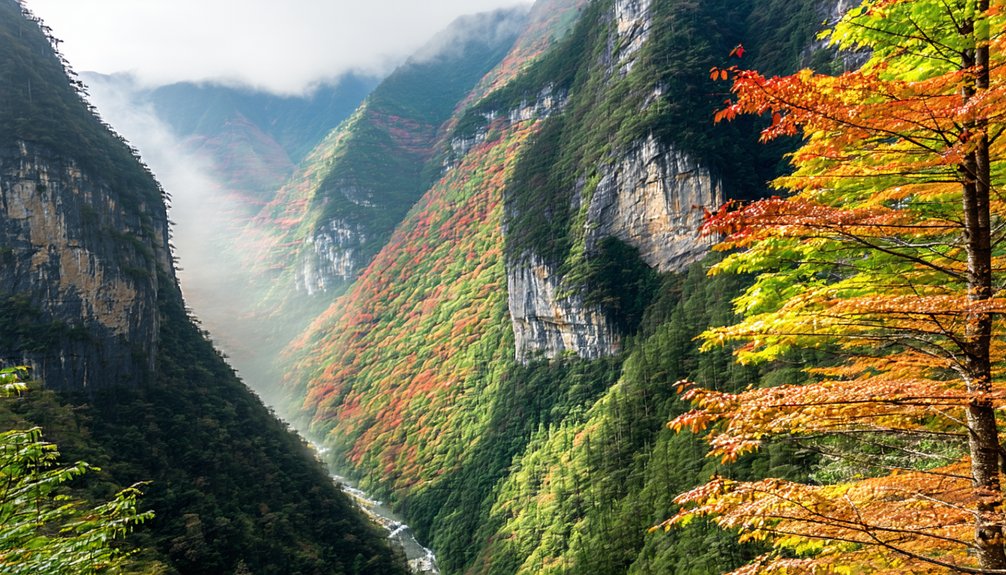
Taiwan’s countless activities and attractions transform with each passing season, offering unique experiences throughout the year. You’ll discover outdoor sports opportunities ranging from spring river tracing in Yilan to summer surfing in Kenting, while agricultural tourism experiences include tea picking in Maokong and citrus harvesting in Hsinchu. The enchanting Pingxi Lantern Festival draws visitors from around the world to release glowing lanterns into the night sky.
Each season brings its distinctive highlights:
- Spring bursts with cherry blossoms at Alishan and colorful flower seas at Yangmingshan
- Summer invites you to explore Green Island’s coral reefs and join the Taitung Hot Air Balloon Festival
- Autumn welcomes hikers to Taroko Gorge’s trails and swimmers to Sun Moon Lake’s carnival
Winter doesn’t slow down, featuring Beitou’s hot springs and rare snow views at Hehuanshan. Year-round, you can immerse yourself in vibrant night markets, cycle scenic routes, and experience aboriginal culture across the island, ensuring there’s never a dull moment in your Taiwan adventure.





